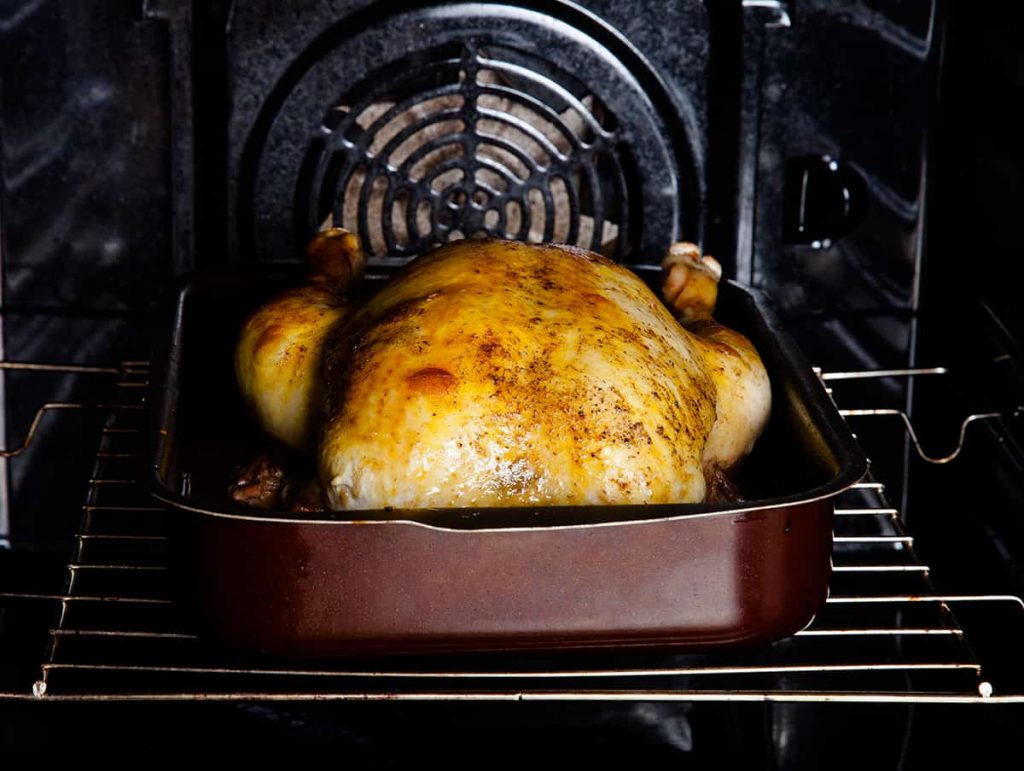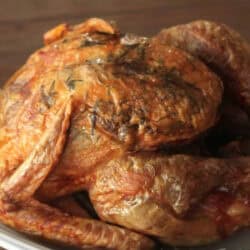Cooking a turkey in a convection oven is will give you a perfectly cooked Thanksgiving turkey. It really is just as easy as using a standard oven to create the perfect turkey for your holiday meal.
I am absolutely in love with our double wall ovens. They make any turkey I cook come out perfectly seared on the outside and juicy on the inside every time. Choose the size of your turkey based on how large your oven is so there are no issues closing the oven door. The size of the turkey is important and should be the first thing you consider.
A whole turkey can take a long time to reach the correct internal temperature, and you will want to make sure you have the correct deep roasting pan. This holiday season make sure that you have the right turkey, baking pan, and the best fresh herbs you can find.
We’ll show you how easy it is to cook a turkey in a convection oven instead of using a conventional oven or regular oven. Cooking a turkey is not an intimidating and it takes less time than you might thing. This turkey turns out so juicy and tender.
For this recipe, you only need a few simple kitchen tools. We recommend using the following equipment:
As Thanksgiving approaches, many home cooks ponder the age-old question: should I use a convection oven to roast my turkey this year? With so many different oven options available, it can be tricky to determine which is best for cooking the star of your holiday table. In this comprehensive guide, we’ll break down the pros and cons of convection ovens to help you decide if using one for turkey is right for you.
What is a Convection Oven?
A convection oven uses a fan to circulate hot air around the interior cavity. This allows heat to move around food more quickly and evenly than a standard radiant oven. The constant flow of air prevents cold spots from developing, resulting in fast, uniform cooking.
Convection ovens have an exhaust system that vents out moisture as well This dual action of circulating air and removing moisture contributes to faster cooking times and excellent browning capabilities
Benefits of Using a Convection Oven for Turkey
There are several advantages that make convection ovens a great choice for roasting turkey:
Faster Cooking Time
The circulating hot air penetrates deep into the turkey cooking it up to 25% faster than a conventional oven. For a large bird, this can translate to over an hour of time savings.
Even Cooking
No more fussing over whether the thighs or breasts will cook faster. The all-around heat of a convection oven ensures even cooking so the entire turkey finishes at the same time.
Crispy Skin
The constant flow of hot, dry air will crisp up the turkey skin beautifully. No need for basting when the convection fan naturally promotes a golden brown exterior.
Juicy Meat
Convection ovens seal in moisture and cook food rapidly. Less time exposed to heat means the turkey stays succulent and tender.
No Hot Spots
With no single heat source, meats cook free of underdone or burnt spots. Convection ovens deliver consistent results corner to corner.
Potential Drawbacks of Convection Ovens
While convection ovens provide outstanding turkey roasting capabilities, there are a couple potential downsides to consider:
Learning Curve
If you’re accustomed to a standard oven, there may be a learning curve in figuring out optimal rack placement and adjusting cook times.
Overcooking Risk
The accelerated cooking of convection ovens makes overcooking more likely if temperature and times aren’t adjusted. Keep a close eye on doneness.
Cost
Convection ovens are generally more expensive than conventional ovens. Make sure it aligns with your budget.
Tips for Convection Roasting Your Turkey
Follow these tips for convection success with your holiday bird:
-
Reduce temperature – Lower the temp 25-50°F compared to regular oven recommendations since hot air cooks faster.
-
Monitor temperature – Use a meat thermometer and check often since cooking happens rapidly.
-
Skip the basting – Let convection do the crisping work for you. Basting will interrupt air flow.
-
Watch rack position – Centering the turkey allows for optimal air circulation.
-
Rest before slicing – Let the turkey rest 20 minutes so juices can redistribute evenly.
-
Cook stuffing separately – Stuffing may not reach a safe temp if cooked inside the turkey.
Convection vs Standard Oven Turkey Roasting
While you can certainly roast a delicious turkey in any oven, convection ovens provide some clear bonuses that justify their popularity for holiday cooking. Here’s a quick comparison:
| Convection Oven | Standard Oven |
|---|---|
| Faster cooking times | Longer cooking times |
| Excellent browning | Moderate browning |
| Built-in moisture control | Needs basting |
| Uniform heating | Potential hot spots |
| Reduced energy use | Higher energy use |
Both ovens can work for turkey assuming proper temperature monitoring. Convection simply offers greater speed, efficiency and foolproof results.
The Verdict: Great for Turkey Roasting
Thanksgiving turkeys shine when cooked in convection ovens. The circulating hot air delivers speedier cooking, crispy skin, juicy meat and effortless evenness from all angles. While conventional ovens will certainly suffice, the advantages of convection technology are hard to beat for roasting this holiday centerpiece.
If you invest in a countertop convection oven or upgrade your standard model to a convection setting, be sure to take it for a test run before the big day. Adjusting cook times and temperatures may take a couple practice runs but you’ll be rewarded with a perfect turkey and extra time to spend with guests. Embrace the convection oven and your next turkey will wow guests with its tender, succulent flavor.

How to Safely Defrost a Turkey
There are three safe ways for defrosting a turkey:
- Under refrigeration. This requires adequate refrigerator space and advanced planning and is the preferred method for defrosting a turkey. The turkey should be placed on the lowest possible shelf to prevent any juices from spilling into other foods. A high-rimmed pan ( 2-3?) is required to catch any juices. Thaw breast side up. Defrost times will depend on the size of the bird. On average, it will take one day per 4 pounds for the bird to be completely defrosted. Plan on defrosting and cooking within a two day time period.
- Using a Large Sink and Running Water. The turkey may be defrosted by placing it in a sink of running water or in a sink of water that will be changed every half hour. Ample room is needed for loose particles and overflow. Special care must be taken in cleaning and sanitizing every tool used in preparation of the turkey. Hot water and a bleach- based cleanser should be used to sanitize the sink and utensils used.
- Using Pure ConvectionTM. You may use Pure ConvectionTM at 150° to defrost a partially frozen turkey for same- day cooking. Partially frozen means that the skin, legs and wings are defrosted and can move freely, but there are still some ice crystals and it is still hard inside of the turkey’s cavity. Place turkey on an oven roasting pan with a v-shaped rack. It will take approximately 8-11 minutes per pound to defrost the turkey. This is not recommended with frozen solid turkeys as it will remain in the Temperature Danger Zone for too long.
No, you do not need to baste. Convection ovens will sear the turkey very quickly, locking No, you do not need to baste. Convection cooking will sear the turkey very quickly, locking in the juices. This is helpful if you are using a shallow roasting pan, as the juices will stay contained. The way the turkey cooks will come down to the cook time.
“Carryover Cooking” is a term to describe the additional cooking a food goes through after it is pulled out of the oven. The turkey will continue to cook approximately 10° more after it is pulled out of the oven. You’ll want to wait to carve into the bird until the turkey is allowed to rest for 10-15 minutes. If you do it too early it will result in a loss of juices.
When cooking in convection, it is best to leave the turkey uncovered so that it benefits from the convection sear. However, if the wings, legs, and top of the turkey begin to brown too much, you certainly can use foil to cover these areas. The entire turkey skin should roast evenly and prove to be a delicious meal.
You can lower the oven temperature by about 50 degrees and cover the turkey with foil. This will slow down the cooking process. You can lower the oven temperature by about 50 degrees and cover the turkey with foil. This will slow down the cooking process and keep the center of the stuffing warm. When you’re ready to eat you can check the whole bird with an oven-safe meat thermometer to make sure it is cooked and ready to eat.
Thaw your turkey in the refrigerator. Frozen turkeys prevent bacteria from growing, but does not kill them. Never defrost a turkey by placing it on the counter or in a warm place. It can cause foodborne illness. A thawed turkey should be out of the Temperature Danger Zone- 40° -140° as a good rule of thumb. This general rule is an easy way to keep your turkey thawing safely.
Enjoy More Delicious Turkey Recipes
Whether you want to cook your turkey in the Instant Pot, slow cooker, or traditional oven roasting, we have got you covered. Check out our comprehensive collection of turkey recipes here.

Is it better to cook a turkey in a convection oven or regular oven?
FAQ
Is it better to cook a turkey in a convection oven or not?
Always use a regular oven for roasting any type of meat. Convection ovens will dry out the meat very quickly, so best to avoid them. You could give your turkey a final blast for a few minutes at the end of cooking to help crisp up the skin.
Is there a downside to a convection oven?
The cons of convection cooking may include a learning curve, recipe adjustment, and higher cost.Jan 1, 2024
What oven setting is best for turkey?
I recommend roasting a turkey at 400°F (204°C) for perfect texture and crispy skin. If the turkey is the only thing in the oven, it should take two hours to up to six hours. I also recommend rotating the turkey 180° once an hour to make sure it cooks evenly.
Is it better to cook a turkey at 325 or 350?
We recommend roasting turkey at 350 degrees F (175 degrees C) for 13 minutes per pound for an unstuffed turkey.Nov 6, 2024
